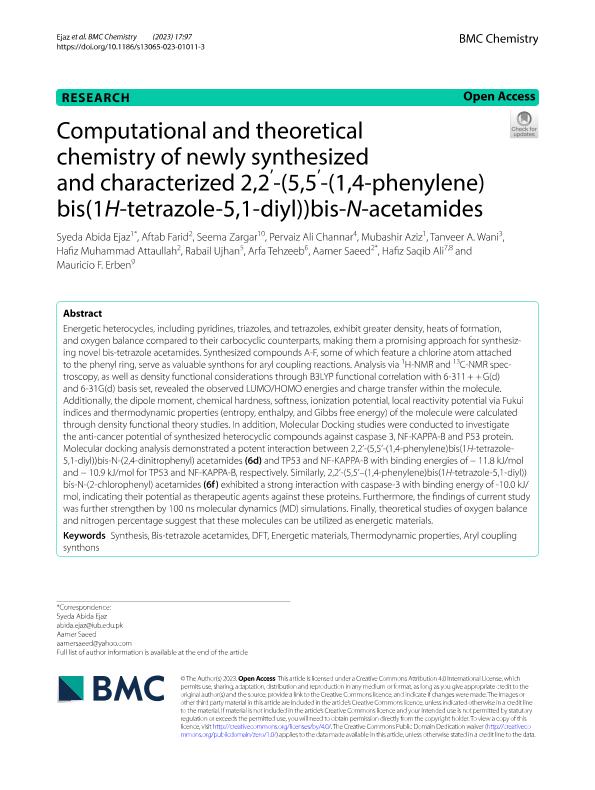Mostrar el registro sencillo del ítem
dc.contributor.author
Ejaz, Syeda Abida
dc.contributor.author
Farid, Aftab
dc.contributor.author
Zargar, Seema
dc.contributor.author
Channar, Pervaiz Ali
dc.contributor.author
Aziz, Mubashir
dc.contributor.author
Wani, Tanveer A.
dc.contributor.author
Attaullah, Hafiz Muhammad
dc.contributor.author
Ujhan, Rabail
dc.contributor.author
Tehzeeb, Arfa
dc.contributor.author
Saeed, Aamer
dc.contributor.author
Ali, Hafiz Saqib
dc.contributor.author
Erben, Mauricio Federico

dc.date.available
2024-02-15T13:08:54Z
dc.date.issued
2023-12
dc.identifier.citation
Ejaz, Syeda Abida; Farid, Aftab; Zargar, Seema; Channar, Pervaiz Ali; Aziz, Mubashir; et al.; Computational and theoretical chemistry of newly synthesized and characterized 2,2’-(5,5’-(1,4-phenylene)bis(1H-tetrazole-5,1-diyl))bis-N-acetamides; BioMed Central; BMC Chemistry; 17; 1; 12-2023; 1-21
dc.identifier.issn
2661-801X
dc.identifier.uri
http://hdl.handle.net/11336/227064
dc.description.abstract
Energetic heterocycles, including pyridines, triazoles, and tetrazoles, exhibit greater density, heats of formation, and oxygen balance compared to their carbocyclic counterparts, making them a promising approach for synthesizing novel bis-tetrazole acetamides. Synthesized compounds A-F, some of which feature a chlorine atom attached to the phenyl ring, serve as valuable synthons for aryl coupling reactions. Analysis via 1H-NMR and 13C-NMR spectroscopy, as well as density functional considerations through B3LYP functional correlation with 6-311 + + G(d) and 6-31G(d) basis set, revealed the observed LUMO/HOMO energies and charge transfer within the molecule. Additionally, the dipole moment, chemical hardness, softness, ionization potential, local reactivity potential via Fukui indices and thermodynamic properties (entropy, enthalpy, and Gibbs free energy) of the molecule were calculated through density functional theory studies. In addition, Molecular Docking studies were conducted to investigate the anti-cancer potential of synthesized heterocyclic compounds against caspase 3, NF-KAPPA-B and P53 protein. Molecular docking analysis demonstrated a potent interaction between 2,2’-(5,5’-(1,4-phenylene)bis(1H-tetrazole-5,1-diyl))bis-N-(2,4-dinitrophenyl) acetamides (6d) and TP53 and NF-KAPPA-B with binding energies of − 11.8 kJ/mol and − 10.9 kJ/mol for TP53 and NF-KAPPA-B, respectively. Similarly, 2,2’-(5,5’–(1,4-phenylene)bis(1H-tetrazole-5,1-diyl))bis-N-(2-chlorophenyl) acetamides (6f) exhibited a strong interaction with caspase-3 with binding energy of -10.0 kJ/mol, indicating their potential as therapeutic agents against these proteins. Furthermore, the findings of current study was further strengthen by 100 ns molecular dynamics (MD) simulations. Finally, theoretical studies of oxygen balance and nitrogen percentage suggest that these molecules can be utilized as energetic materials.
dc.format
application/pdf
dc.language.iso
eng
dc.publisher
BioMed Central

dc.rights
info:eu-repo/semantics/openAccess
dc.rights.uri
https://creativecommons.org/licenses/by/2.5/ar/
dc.subject
ARYL COUPLING SYNTHONS
dc.subject
BIS-TETRAZOLE ACETAMIDES
dc.subject
DFT
dc.subject
ENERGETIC MATERIALS
dc.subject
SYNTHESIS
dc.subject
THERMODYNAMIC PROPERTIES
dc.subject.classification
Química Inorgánica y Nuclear

dc.subject.classification
Ciencias Químicas

dc.subject.classification
CIENCIAS NATURALES Y EXACTAS

dc.title
Computational and theoretical chemistry of newly synthesized and characterized 2,2’-(5,5’-(1,4-phenylene)bis(1H-tetrazole-5,1-diyl))bis-N-acetamides
dc.type
info:eu-repo/semantics/article
dc.type
info:ar-repo/semantics/artículo
dc.type
info:eu-repo/semantics/publishedVersion
dc.date.updated
2024-02-14T12:16:44Z
dc.journal.volume
17
dc.journal.number
1
dc.journal.pagination
1-21
dc.journal.pais
Países Bajos

dc.description.fil
Fil: Ejaz, Syeda Abida. University of Bahawalpur; Pakistán
dc.description.fil
Fil: Farid, Aftab. Quaid-I-Azam University Islamabad; Pakistán
dc.description.fil
Fil: Zargar, Seema. King Saud University; Arabia Saudita
dc.description.fil
Fil: Channar, Pervaiz Ali. Dawood University of Engineering and Technology Karachi; Pakistán
dc.description.fil
Fil: Aziz, Mubashir. The Islamia University of Bahawalpur; Pakistán
dc.description.fil
Fil: Wani, Tanveer A.. King Saud University; Arabia Saudita
dc.description.fil
Fil: Attaullah, Hafiz Muhammad. King Saud University; Arabia Saudita
dc.description.fil
Fil: Ujhan, Rabail. University of Sindh; Pakistán
dc.description.fil
Fil: Tehzeeb, Arfa. Quaid-I-Azam University Islamabad; Pakistán
dc.description.fil
Fil: Saeed, Aamer. Quaid-I-Azam University Islamabad; Pakistán
dc.description.fil
Fil: Ali, Hafiz Saqib. University of Manchester; Reino Unido
dc.description.fil
Fil: Erben, Mauricio Federico. Consejo Nacional de Investigaciones Científicas y Técnicas. Centro Científico Tecnológico Conicet - La Plata. Centro de Química Inorgánica "Dr. Pedro J. Aymonino". Universidad Nacional de La Plata. Facultad de Ciencias Exactas. Centro de Química Inorgánica "Dr. Pedro J. Aymonino"; Argentina
dc.journal.title
BMC Chemistry
dc.relation.alternativeid
info:eu-repo/semantics/altIdentifier/doi/http://dx.doi.org/10.1186/s13065-023-01011-3
Archivos asociados
